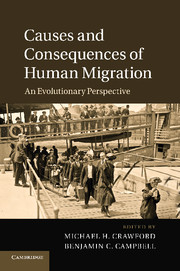Book contents
- Frontmatter
- Contents
- Contributors
- Preface
- 1 Perspectives on human migration: introduction
- Section 1 Theory
- 2 Genetic evidence concerning the origins and dispersals of modern humans
- 3 The biology of human migration: the ape that won’t commit?
- 4 Evolutionary basis of human migration
- 5 Evolutionary consequences of human migration: genetic, historic, and archaeological perspectives in the Caribbean and Aleutian Islands
- 6 Kin-structured migration and colonization
- 7 The role of diet and epigenetics in migration: molecular mechanisms underlying the consequences of change
- Section 2 Geography and migration
- Section 3 Overview
- Index
- References
4 - Evolutionary basis of human migration
Published online by Cambridge University Press: 05 December 2012
- Frontmatter
- Contents
- Contributors
- Preface
- 1 Perspectives on human migration: introduction
- Section 1 Theory
- 2 Genetic evidence concerning the origins and dispersals of modern humans
- 3 The biology of human migration: the ape that won’t commit?
- 4 Evolutionary basis of human migration
- 5 Evolutionary consequences of human migration: genetic, historic, and archaeological perspectives in the Caribbean and Aleutian Islands
- 6 Kin-structured migration and colonization
- 7 The role of diet and epigenetics in migration: molecular mechanisms underlying the consequences of change
- Section 2 Geography and migration
- Section 3 Overview
- Index
- References
Summary
Introduction
Human migration is not only a ubiquitous process in the modern world, but one with deep roots. The ease of travel today has greatly accelerated migration, leading not only to increased rates of migration, but to new forms such as transnational migration in which families move to a new country only long enough to move on to another. At the same time, recent finds in the fossil record make it clear that humans and their immediate ancestors have been migrating in one form or another since the origins of the genus Homo, almost 2 million years ago.
Such antiquity suggests that migration itself may be a context for natural selection, linking success in migration with successful reproduction (Wells and Stock, 2007; Wells and Stock, this volume). If so, we can expect that migration has left traces in the human genome that link ancient and modern human migration. These would include not only the neutral markers that have been used to trace movements of human populations (see this volume), but beneficial genes selected for by successful migration.
- Type
- Chapter
- Information
- Causes and Consequences of Human MigrationAn Evolutionary Perspective, pp. 45 - 64Publisher: Cambridge University PressPrint publication year: 2012
References
- 8
- Cited by



